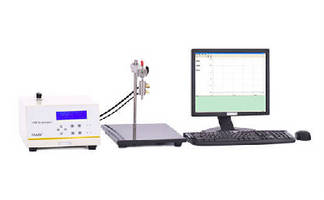Testing Sealing Capability of Flexible Package Bags Using LSSD

LSSD(Leak and Seal Strength Detector is a new instruments presented by Labthink), based on positive pressure method, can test the whole and partial seal-leakage character of flexible packages such as caps, containers, flexible tubes and so on. It is the sealability testing instrument with the most complete testing index at present and can accomplish special testing items of flexible packages such as open packages and closed packages with testing accessory.
1. Sealability Testing Summary
The most important property of packages is its sealabilty, the barrier property of package materials will fail and its contents will deteriorate as gases and liquids penetrate into and from packages through leak point. But indexes related to seal ability of each packaging style are different. For example, as to flexible packages made by heat seal technology, heat sealing edge is the position most likely to leak. Sealing strength is the most important factor relevant to sealability of packages, so we need to test heat seal strength, the quality of heat seal, the burst pressure and the seal-leakage character of each heat seal edges of the flexible packages. But as to pileproof closure, we need to test sealability of cap, the torsional airproof index of cap, the cap joint and disengaging strength. These indexes will provide data to analysis leakage as the basis for perfection for package designers and manufacturers.
For heat seal packages, high temperature in heat seal operation may affect mechanical strength of packaging material nearby, so materials around the heat seal edges are the weakest of flexible packaging sealability. When imposing pressures on flexible packages, pressures borne by different parts of packages are not the same. However, the places that leak at first are the places bearing the lowest pressure. So we must test products of packages if we want to evaluate sealability of flexible packages accurately.
2. Introduction to LSSD
2.1 Advantages of LSSD Testing
In practical use, unlike positive pressure method, negative pressure method has some limitations in opening packages test. LSSD combines various leakage test technologies on the basis of positive pressure test technology, and expands the objects of test from flexible packaging bags to containers, caps, flexible tubes etc. Meanwhile, it clarifies the testing position. For example, test the seal property of heat seal edges by restraining plate and test opening packages using opening package testing instrument.
2.2 Introduction of LSSD Test
There are three ways to test flexible package bags with LSSD. They can be applied to evaluate the sealability of flexible package bags at each step of packaging.
Burst Test: puffing air into packages to increase the inside pressure until the packages burst. This testing method can test the maximum bursting pressure of the specimen.
Creep Test: keeping pressures inside packages for a regulated period of time. Specimens that do not leak during the test are classified as “passed”; otherwise, classified as “failed”.
Creep to Failure: increasing pressures inside flexible package bags to a specified pressure and keep it until the packages leak. The pressure is higher compared to that of creep test, to ensure that package is broken within a reasonable period of time. This test gets the interval times of packages that can endure the pressure until leaking.
2.3 The Applications of Restraining Plate
Bursting is likely to appear at the edges of heat seal and surface of flexible package bags that are of the worst sealability of flexible package bags, including materials of flexible package bags. By using restraining plates, accurate and quantitative restricts to expansion and distortion of flexible package bags is made; pressure concentration is evenly distributed on the edge of heat seal. So with the application of restraining plates, the sealability of flexible package bags can be tested directly with great practicality.
2.4 Open Package and Closed Package
There are various kinds of flexible package bags, but basically, there are two kinds -- open package and closed package. Generally, flexible packages that are thoroughly sealed and can stand stresses at the edges of heat seal are closed packages, like middle-sealed bags, four-edge sealed bags, and self-supporting bags. A circular hole which would be sealed after the insertion of puffing probe must be opened at the center of bags before test. The position of circular hole may affect the result of test, and we suggest the opening position at the center of specimen. Three side seal bag, hand bag and shopping bag, etc. belong to the category of open package. We can only test the seal characters of materials and the three sides except the unsealed one with specially made accessories. For example, the LSSD-01P Leak and Seal Strength Detector of Labthink with different position from that of closed package. Of course, users can implement sealability test of heat seal edges of open package by using LSSD-01P and LSSD-01R restraining plates.
3. Conclusion
We can test the sealability of various flexible packages more thoroughly and systematically; and analyze the ultimate reason of bursting by using LSSD. LSSD can also analyze and improve the thickness of materials of heat seal layers, burst resistance strength of films and relevant heat seal indexes, or change heat seal materials; and can combine other testing methods to evaluate the integrality of content of package, consistency of sealability of package and open character of content of package. The testing objects of LSSD test have been widely expanded from flexible package bags to containers, caps, flexible tubes and so on.




